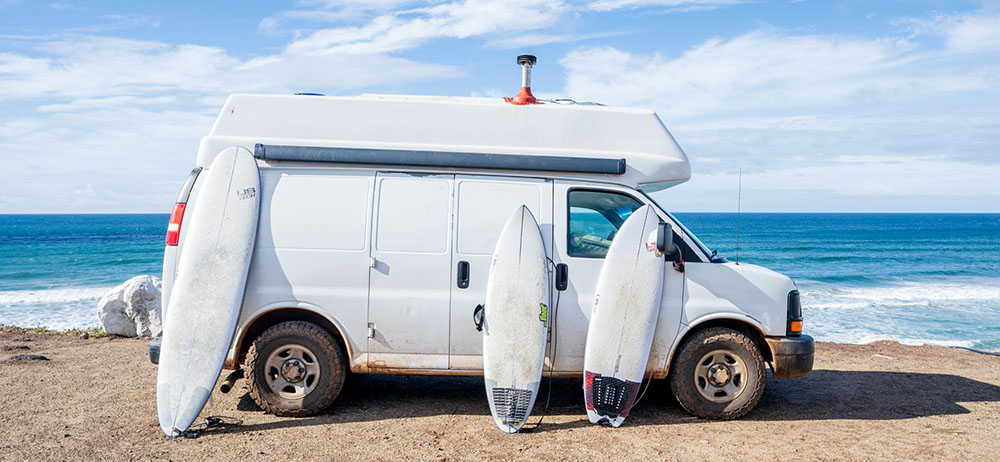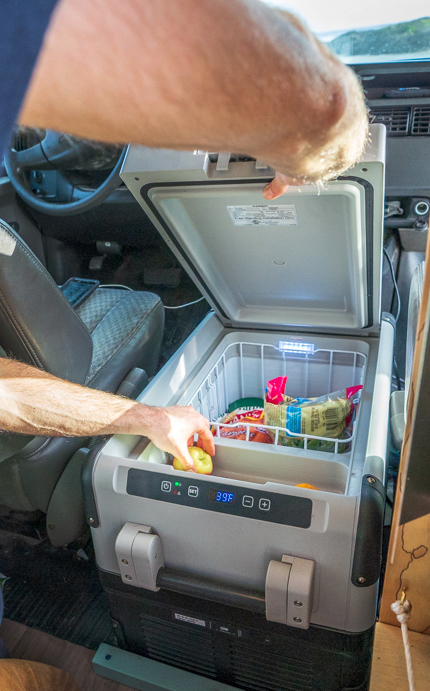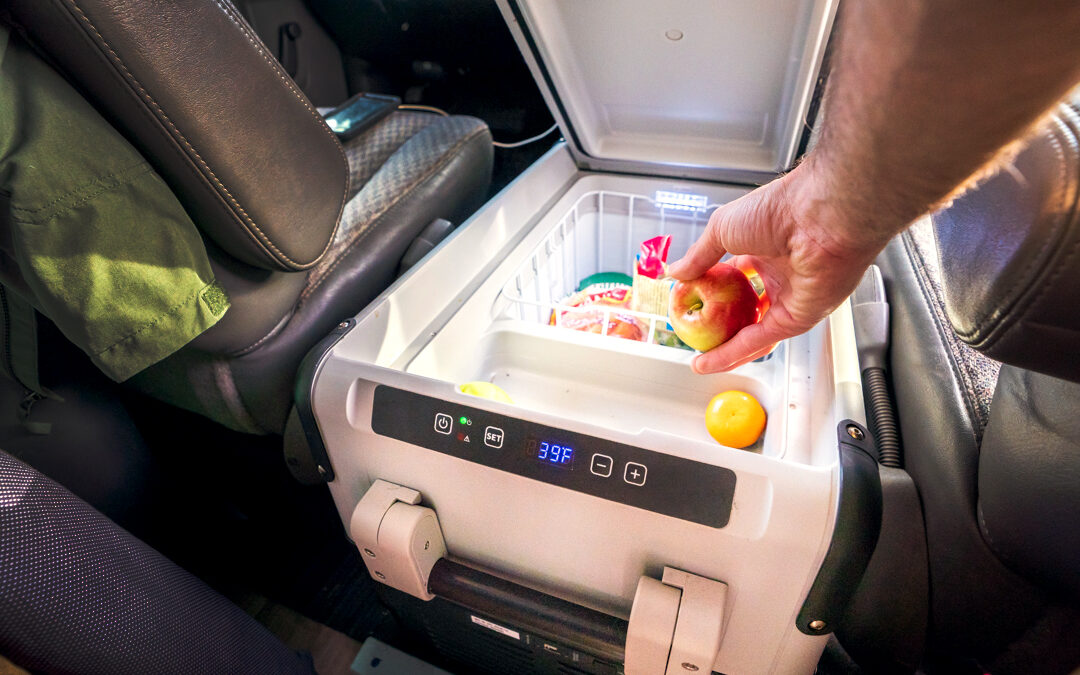Okay—the Dometic CFX isn’t exactly what you expect when you read “refrigerator”—it’s more of a top-loading cooler with a built-in electrical system. Call it a refrigerating cooler, call it a cool refrigerator, the Dometic CFX is optimized for life on the road. Due to the rugged build, compact size, and minimal drain on your precious electrical system, the Dometic CFX is our top choice for vanlifers, overlanders, and anyone who has minimal amps and inches to spare.
Just to clarify, in this review, we’ll be talking about Dometic’s CFX lineup. While a few CFX products are still on the market, the CFX3 is Dometic’s more current offering. That said, we wanted to share our experience of the CFX, which we’ve used regularly for four years without issue. Our feeling is that this gives you a great sense of the durability of the product, and reviews of the CFX3 seem to back up that up. Without further ado, let’s get into it.

Why Go Electric?
Going with a regular, run-of-the-mill (non-electric) cooler is certainly an option, and we know several folks who opted for heavy-duty coolers over electrical alternatives. Coolers from Yeti and Otterbox can keep grub and beers cool for days on end, and even those expensive, top-of-the-line models are way cheaper than pricier premium electrical coolers a la Dometic CFX. However, it’s a pain in the ass to go to the grocery store to re-up on ice all of the time. Also, wet, soggy sandwiches and bobbing veggies are similarly annoying. For full-time vanlifers—or anyone who’s installing an electrical system in their vehicle—going with a minimalist fridge is a smart move.
Sizing the Dometic CFX:
Dometic offers a slew of sizes for the CFX lineup, ranging from the petit CFX 28 to the mammoth CFX 100. We’ll include links to all of the sizes below. For the sake of this review, however, we’ll be talking about the CFX-35, which best suited our needs.
Given the size of our van (a 2006 Chevy Express with a fiberglass topper AKA Acorn), we planned to sandwich a CFX in between the front seats. That plan went off without a hitch, and we settled on the Dometic CFX 35—it’s as big as we could go while still allowing for some airflow. Remember, the vents on the side of the cooler can’t be covered or the unit will overheat.

What We Love:
Electrical Draw: One of the main reasons we were attracted to the CFX was the low power draw. For those who like to nerd out on electrical specs, Dometic lists the initial startup current at 7A (12V), and at 90 degrees Fahrenheit with an ambient temperature of 90 and a compartment temp of 41, the CFX subsists on a dainty .77Ah/h.
If you’re not a nerd and those numbers mean nothing to you, this draw is beyond reasonable and helps explain why the cooler is so expensive. We have a very minimal electrical system, with a single 125A auxiliary battery, and we’ve yet to have any problems with the fridge draining our juice. Granted, we set the fridge to 43 degrees and are very conscious of our electrical consumption, minimizing electrical draw whenever possible (i.e. charging phones while driving, charging laptops when we work in coffee shops, etc). Regardless, if you’re running on a bigger electrical system or a smaller one like ours, the CFX will help you live off-the-grid as long as possible.
Ruggedness: You can tell from the design—the rubberized corners, the dual colorway, the burly plastic build—Dometic designed this thing for people like you and me. Burly folks. Gnarly van dwellers. The kind of rambling nomads to spend a week in the crags of Utah or the river valleys of the Tetons and not shower once—but still whip up tasty quinoa stir-fries on the regular. All jokes aside, this cooler is a beast. Katie and I often use it as a seat, and sometimes even step on the lid in order to hop in the front seat or reach into the dark, dingy recesses of our storage. Major points for durability.
Installation: Fact: installation of a top-loading cooler is way easier than installing a fridge. You just find a spot, plop it down, and secure it in place. All we had to do once we dropped the CFX 35 in between our arm rests was to drill a piece of 2×2 into the floor to keep the cooler from zooming into the living area should we drive up a steep incline.
As far as the electrical installation, that was a breeze, too. The CFX can take AC or DC electricity, and comes with two cords. The AC has a plug that goes into the wall socket. We never use that—we live in a van. The DC comes with a typical car jack plug. This might be a decent option for folks who are weekend warriors, but we wanted to have the fridge be running constantly off of our auxiliary battery. As such, we snipped off the car jack, determined which wire was positive by using an electric meter, and wired the refrigerator into our circuit breaker. Easy peasy.
What We Don’t Love:
There’s nothing we hate about the CFX 35, but we if we’re going to nitpick, we do have two gripes, and they both have to do with size.
Single Compartment: The 35 version has a single compartment. The temperature range does dip down to -7 degrees, so keeping things frozen isn’t a problem, but you have to freeze everything if you want to freeze anything. Rock-hard hummus isn’t really our cup of tea, so we keep the cooler at 43 degrees and dream of ice cream.
However, the dual zone CFX 75DZW and the CFX 95 DZW are both options for those who want a top-loading design with both fridge and freezer.
Deceiving Dimensions:
When you look at the external dimensions of the CFX 35, you say, okay, cool, this looks like a pretty typical Yeti 35-Liter cooler. However, the CFX 35 actually only has 32L capacity. This is due to the fact that the internal motor—yes, there’s a motor in there, this thing doesn’t run on magic—takes up a few liters of room. The CFX 35 holds 47 cans, but that’s at it’s most efficient. When you’re tossing in cauliflower and eggs and pickle jars, chances are you’re not using space quite as efficiently.
Again, the best way to solve this problem is to size up. You can snag the CFX 40, which has the same width and length but is simply a smidge taller. Or, you can step up to bigger sizes like the CFX 50 and CFX 60, or really ball out with a dual-zone 75 or 95. You know what’s neat? Even sizing up to the larger sizes, the electrical draw remains more than reasonable. The biggest cooler, the CFX 100W, takes 10.5A to start up, and drops to 1.5 Ah/h when ambient temp is 90 degrees and compartment temp is 41 degrees.
Final Verdict: The Dometic CFX 35 is the best vanlife cooler for our needs, and chances are it might be for yours as well. Of course, if you’re looking for a little more or less space, you can always switch up the sizing. While we don’t have firsthand experience with other sizes, other reviewers seem similarly content with the entire range. The CFX coolers are rugged, well-built, and can take a beating (or a seating). They barely drain your battery life. All things considered, the Dometic CFX puts the “cool” in cooler.
Happy travels,
Groves & Coves

